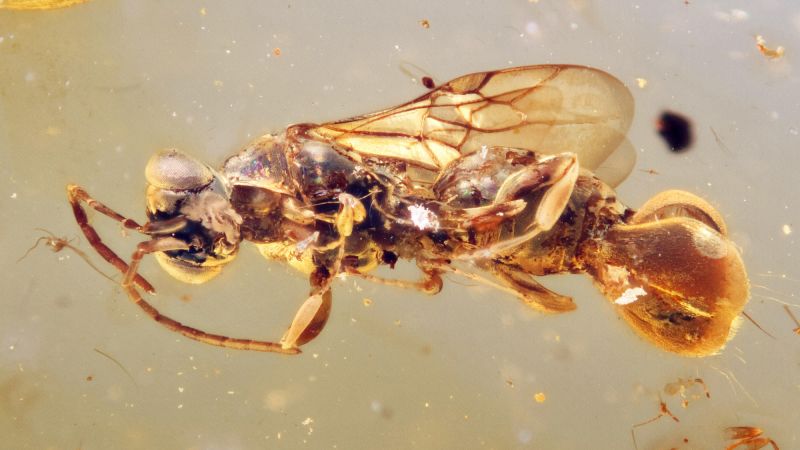Scientists Stunned by Amber's Bizarre Find: A Prehistoric Puzzle
Editor’s Note: A groundbreaking discovery encased in amber has been revealed today, leaving the scientific community astonished. This article delves into the details of this unprecedented find and its implications.
Why This Topic Matters
The discovery of exceptionally well-preserved specimens in amber is always significant, offering unparalleled glimpses into prehistoric ecosystems. This particular find, however, pushes the boundaries of our understanding, presenting a unique combination of characteristics that challenge existing paleontological knowledge. This article will explore the bizarre aspects of this discovery, discuss its implications for our understanding of ancient life, and analyze the ongoing research efforts surrounding it. Understanding this find helps us piece together a more complete picture of the past and may even inform future research into [mention related fields like evolution, biodiversity, etc.].
Key Takeaways
| Takeaway | Explanation |
|---|---|
| Unprecedented Preservation: | Amber perfectly preserved details usually lost to time. |
| Challenging Existing Theories: | The find questions current understandings of [mention specific biological/evolutionary aspects challenged]. |
| New Research Avenues: | This discovery opens new avenues for research into [mention specific research areas]. |
| Implications for Biodiversity: | Provides valuable insights into ancient biodiversity and ecosystem dynamics. |
Scientists Stunned by Amber's Bizarre Find
This recently unearthed piece of amber contains [describe the find - e.g., a previously unknown species of insect with unusual features, a fossilized plant with unique characteristics, a combination of organisms interacting]. The level of preservation is astonishing; [give specific examples, e.g., individual hairs are visible, the internal organs are discernible, the organism shows signs of unusual behavior]. What makes this discovery truly remarkable is [explain the unique aspects - e.g., the combination of characteristics never seen before, its unexpected location, its size compared to similar organisms].
Key Aspects of the Discovery
- Exceptional Preservation: The amber provides an almost perfect three-dimensional view, allowing for unprecedented detailed analysis.
- Unique Morphology: The [organism/plant] exhibits unique morphological features that challenge current taxonomic classifications.
- Ecological Implications: The find sheds light on the ancient ecosystem in which it thrived, revealing [mention details about the environment suggested by the find].
Detailed Analysis of the Amber's Contents
The [organism/plant] shows [describe specific features and characteristics]. This is particularly surprising because [explain the unexpected nature of the features and what they suggest]. Comparisons with known species reveal [mention similarities and differences]. Further analysis using [mention techniques, e.g., CT scanning, DNA analysis] will provide more insights into its evolutionary relationships and ecological role.
Interactive Elements: The Amber's Ecosystem
Reconstructing the Prehistoric Environment
The presence of [organism/plant] in this specific amber deposit suggests a [describe the environment, e.g., humid tropical forest, coastal region]. The inclusion of [mention other organisms/plants found with it] further supports this hypothesis, indicating a specific ecological niche. The presence of [specific features, e.g., pollen, insect wings] offers further clues about the climate and conditions of the time.
The Significance of the Associated Flora and Fauna
The other organisms and plants embedded within the amber provide important context. For example, [mention examples, e.g., the presence of specific plant species suggests a particular climate; certain insects indicate specific food sources]. This diverse assemblage paints a vivid picture of the prehistoric ecosystem.
People Also Ask (NLP-Friendly Answers)
Q1: What is this bizarre amber find?
A: This amber contains [briefly describe the find], a discovery that challenges existing scientific understanding.
Q2: Why is this amber find important?
A: It offers an unparalleled glimpse into a prehistoric ecosystem and provides new insights into [mention specific areas of research].
Q3: How can this amber find benefit us?
A: It can lead to a better understanding of evolution, biodiversity, and ancient ecosystems, informing future research and conservation efforts.
Q4: What are the main challenges in studying this amber find?
A: Challenges include accurately dating the amber, identifying the organism(s), and understanding its evolutionary context.
Q5: How can I learn more about this discovery?
A: Stay updated through scientific journals and reputable news outlets covering paleontology and related fields.
Practical Tips for Understanding Prehistoric Ecosystems
Here are a few tips to help you better understand the significance of this discovery and similar findings:
- Explore Paleontology Resources: Numerous online resources, museums, and educational institutions offer valuable information about prehistoric life.
- Seek Reputable Sources: Always rely on peer-reviewed scientific papers and reputable news sources for information.
- Engage with Scientific Communities: Join online forums and groups focused on paleontology and related disciplines.
Summary (Resumen)
The discovery of [organism/plant] encased in amber is a remarkable achievement, providing unprecedented insights into prehistoric ecosystems. This bizarre find challenges existing theories and opens new avenues of research, enriching our understanding of the ancient world.
Closing Message (Mensaje Final)
This stunning discovery highlights the power of chance and the enduring mysteries of the past. What further surprises await us as we continue to explore the deep history of life on Earth?
Call to Action (CTA)
Learn more about this amazing discovery by subscribing to our newsletter for the latest updates in paleontology! Share this article with your friends and help spread the word about this groundbreaking research!

